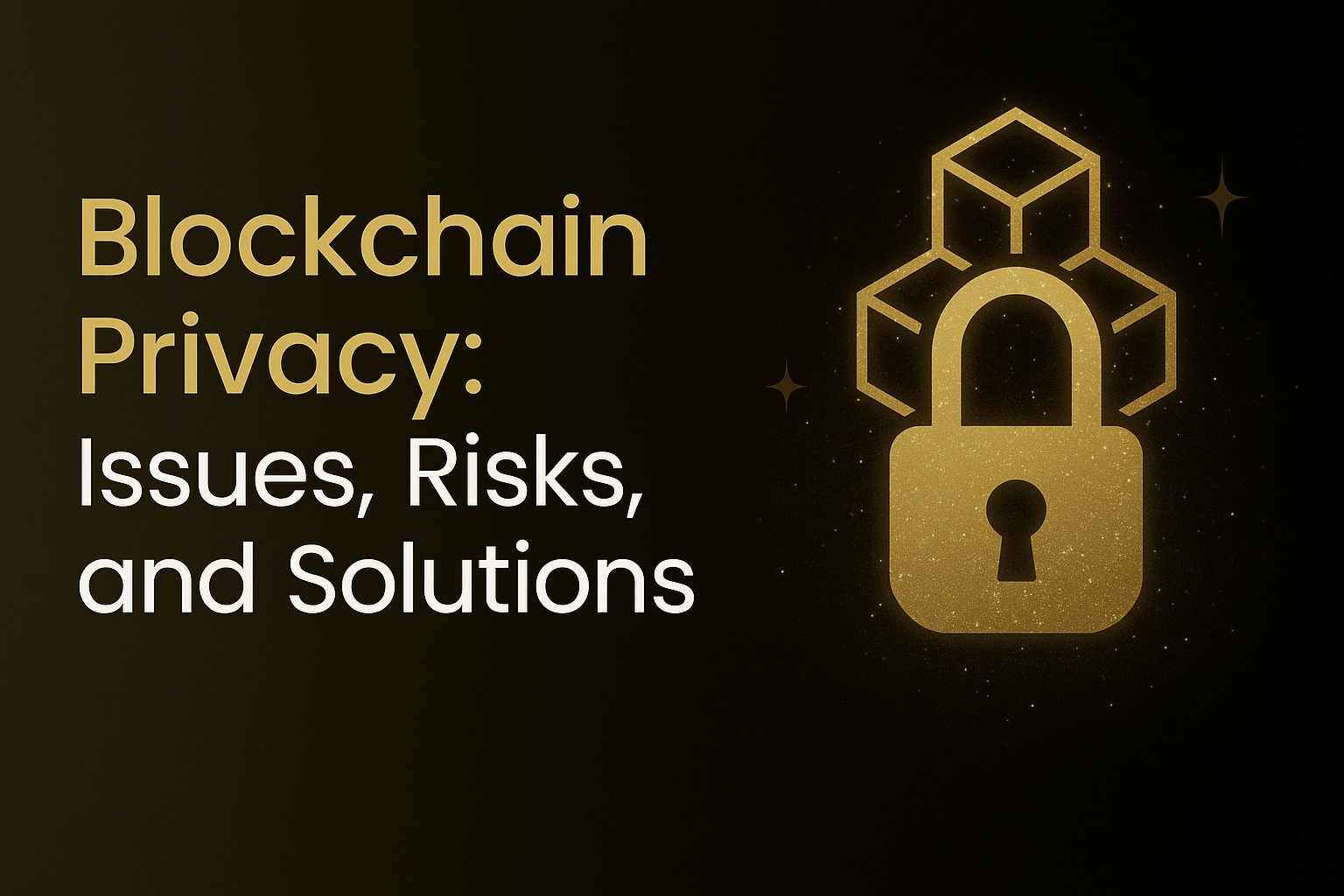Blockchain is often described as both secure and transparent. While transparency is valuable for building trust, it also creates privacy challenges. Every transaction recorded on a blockchain is visible to anyone. As a result, this openness raises concerns for users who value confidentiality. From exposing financial activity to linking wallets with identities, blockchain privacy issues create serious risks. Therefore, in this guide, we will break down the main privacy problems, the risks they cause, and the solutions being developed to address them.

Understanding Blockchain Privacy Issues
Blockchains, such as Bitcoin and Ethereum, are public ledgers. Every wallet address and transaction is visible, even if names are not included. Consequently, over time, patterns and activity can be linked to real identities.
Key concerns include:
- Transaction traceability. Since every transfer is permanently recorded, anyone can view it.
- Address re-use. When users repeatedly use the same address, it becomes easier for observers to build a profile of their behavior.
- Linkability. Wallet addresses can connect to real names when users interact with exchanges that require KYC.
- Smart contract transparency. Because all smart contract code and interactions are visible, private activity becomes difficult.
In short, these blockchain privacy issues reveal the gap between transparency and user protection.
For a basic refresher, read Blockchain Terms and Definitions, A Guide to Crypto.
Risks of Blockchain Privacy Issues
Blockchain privacy challenges pose significant risks to individuals, businesses, and regulators in the real world. More importantly, they can lead to unintended consequences.
- Financial exposure. Competitors or attackers can monitor wallets to study spending or strategies.
- Security risks. Hackers often target high-value wallets by tracking large transactions.
- Loss of anonymity. If a wallet address is linked to your name once, all past and future activity becomes traceable.
- Regulatory conflicts. Full transparency may conflict with privacy laws, such as GDPR, creating compliance issues.
Therefore, these risks highlight why blockchain privacy is not just a technical problem but also a personal and legal concern.
Solutions to Blockchain Privacy Issues
Developers and researchers are working on tools and strategies that improve privacy without removing transparency completely. In fact, multiple approaches already exist.
1. Privacy Coins
Coins such as Monero (XMR) and Zcash (ZEC) use cryptography to hide transaction details. They mask the amount, the sender, and the receiver. As a result, they provide strong protection for users who prioritize confidentiality.
2. Mixing Services and Tumblers
These services mix multiple transactions, making it harder to trace funds. However, they often raise regulatory concerns and can be misused. Nevertheless, they show how users seek to hide their activity.
3. Zero-Knowledge Proofs (ZKPs)
Zero-knowledge proofs let someone prove a fact (such as sending funds) without revealing the details. Zcash uses this, and the concept is spreading across blockchain privacy solutions. Thus, ZKPs are becoming a foundation for modern privacy tools.
4. Layer 2 and Off-Chain Solutions
Off-chain and second-layer solutions reduce the information stored on the main blockchain. Consequently, this not only improves scalability but also enhances privacy.
5. Better Wallet Practices
Simple actions help. For example, create a new wallet address for each transaction. Avoid re-using addresses. In addition, consider combining wallets with VPNs or privacy coins for stronger protection.
Balancing Blockchain Privacy and Regulation
Blockchain privacy tools must balance personal freedom with compliance. Regulators worry that privacy coins, mixers, and advanced tools may enable money laundering or crime. On the other hand, users need protection from exposure. The future of blockchain privacy depends on cooperation between developers, businesses, and governments. Ultimately, a middle ground can give users security while also meeting legal standards.
For additional context on balancing transparency and protection, read Smart Contract Security Audit: Identifying Authentic Contracts.
Everyday Blockchain Privacy Tips
Beyond advanced tools, users can protect themselves by building good habits. After all, technology alone is not enough.
- Avoid oversharing. Do not post your wallet address publicly unless necessary.
- Use privacy-friendly wallets. Some wallets include built-in privacy features.
- Limit exchange use. Move funds off exchanges to personal wallets after trading.
- Combine tools. Use privacy coins, new addresses, and VPNs together for stronger protection.
As a result, adding these practices increases personal safety without relying only on advanced technology.
Business Risks and Blockchain Privacy
Organizations also face risks related to blockchain privacy. In particular, companies that handle sensitive transactions must take extra care.
- Customer confidentiality. Businesses handling crypto payments may expose customer spending habits.
- Competitive intelligence. Competitors could analyze blockchain data to gain insights.
- Reputation risks. Privacy leaks may reduce customer trust.
Therefore, companies must invest in blockchain privacy solutions and policies to keep data secure while remaining compliant.
The Future of Blockchain Privacy
The future of blockchain privacy depends on both innovation and regulation. Moreover, it will be shaped by user demand for more protection.
- More zero-knowledge applications. ZKPs will likely power many upcoming privacy tools.
- Stronger wallets. Wallets will include better privacy defaults.
- Regulatory clarity. Governments will release clearer rules for privacy technologies.
- Hybrid solutions. Expect a mix of public transparency and private channels.
Ultimately, the push for blockchain privacy will continue to grow as adoption spreads into industries like healthcare, finance, and supply chains.
Conclusion
Blockchain transparency is both a strength and a weakness. It builds trust but creates privacy concerns. Therefore, blockchain privacy tools such as privacy coins, zero-knowledge proofs, and strong wallet practices help reduce risks. At the same time, regulators, businesses, and developers must work together to balance innovation and compliance. In the end, blockchain privacy is more than a technical feature—it is central to building long-term trust in the digital economy.
For more insights, check A Guide to Smart Contracting and Colors, Shapes, Safety, Blockchain Made Simple.
